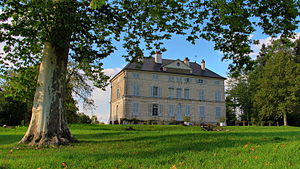Boulot
| Boulot | ||
|---|---|---|
|
|
||
| region | Bourgogne-Franche-Comté | |
| Department | Haute-Saône | |
| Arrondissement | Vesoul | |
| Canton | Rioz | |
| Community association | Pays Riolais | |
| Coordinates | 47 ° 21 ′ N , 5 ° 58 ′ E | |
| height | 209-287 m | |
| surface | 7.08 km 2 | |
| Residents | 690 (January 1, 2017) | |
| Population density | 97 inhabitants / km 2 | |
| Post Code | 70190 | |
| INSEE code | 70084 | |
 Boulot Castle |
||
Boulot is a municipality in the French department of Haute-Saône in the region Bourgogne Franche-Comté .
geography
Boulot is located at an altitude of 220 m above sea level, about 13 kilometers north-northwest of the city of Besançon (as the crow flies). The village extends in the south of the department, on the northern edge of the valley plain of the Ognon , in the valley of the Tounolle west of the forest heights of the Grands Bois.
The area of the 7.08 km² large municipal area includes a section of the middle Ognon Valley. The southern border always runs along the Ognon. This flows here with several turns to the west through an alluvial plain , which has a width of about two kilometers and averages 215 m. From the course of the river, the community area extends northward over the valley level to the adjacent plateau, which is made up of tertiary sediments . In the eastern part is the valley system of the Tounolle and its side stream, which rises in Creux les Brez . To the east of the Tounolle valley, the communal soil extends to the ridge of the Grands Bois , on which Boulot's highest peak is reached at 287 m. This ridge consists of limestone layers from the upper Jurassic period .
Neighboring communities of Boulot are Chaux-la-Lotière and Boult in the north, Bussières in the east, Cussey-sur-l'Ognon in the south and Étuz in the west.
history
Boulot was first mentioned in a document in 1203 under the name Bolat . The place name is a diminutive form of Boult (neighboring municipality) and is derived from the old French word boul (birch). In the Middle Ages, Boulot belonged to the Free County of Burgundy and in it to the area of the Bailliage d'Amont . The Lords of Boult held local rule over the village. Together with Franche-Comté , Boulot finally came to France with the Peace of Nijmegen in 1678. Iron ore was mined and processed here in the 19th century. Today Boulot is a member of the community association Communauté de communes du Pays Riolais, which comprises 33 localities .
Attractions
The village church of Saint-Christophe was built in 1773 and has rich furnishings from this period.
The Château de Boulot also dates from the 18th century.
population
| Population development | |
|---|---|
| year | Residents |
| 1962 | 164 |
| 1968 | 207 |
| 1975 | 256 |
| 1982 | 335 |
| 1990 | 388 |
| 1999 | 423 |
With 523 inhabitants (2005), Boulot is one of the small communities in the Haute-Saône department. After the population had decreased significantly in the first half of the 20th century (in 1901 there were still 299 people), strong population growth has been recorded again since the beginning of the 1960s. Since then, the number of inhabitants has more than tripled.
Economy and Infrastructure
Until well into the 20th century, Boulot was a village dominated by agriculture (arable farming, fruit growing and cattle breeding). Today there are various local small businesses. In the last few decades the village has transformed into a residential community. Many workers are therefore commuters who go to work in the larger towns in the area and in the Besançon agglomeration.
The village is located away from the major thoroughfares on a department road that leads from Rioz to Étuz. The closest connection to the A36 motorway is around 13 km away. There are other road connections with Voray-sur-l'Ognon and Chaux-la-Lotière.
